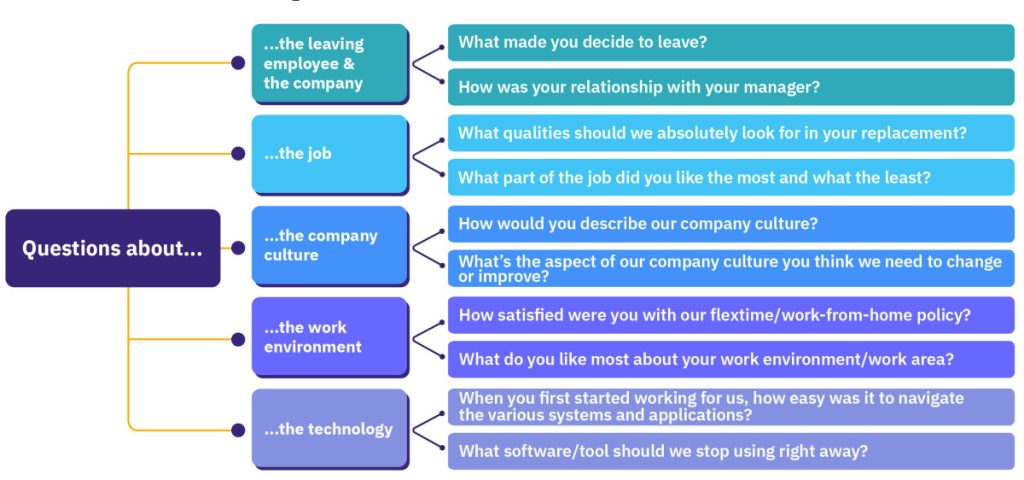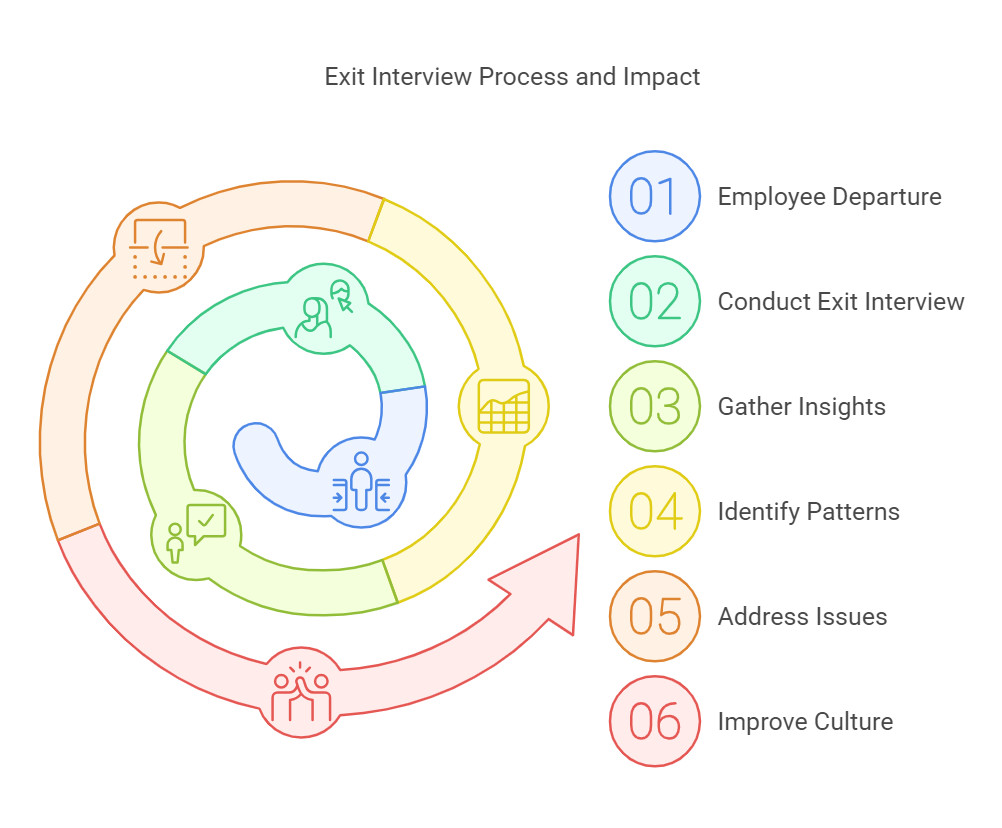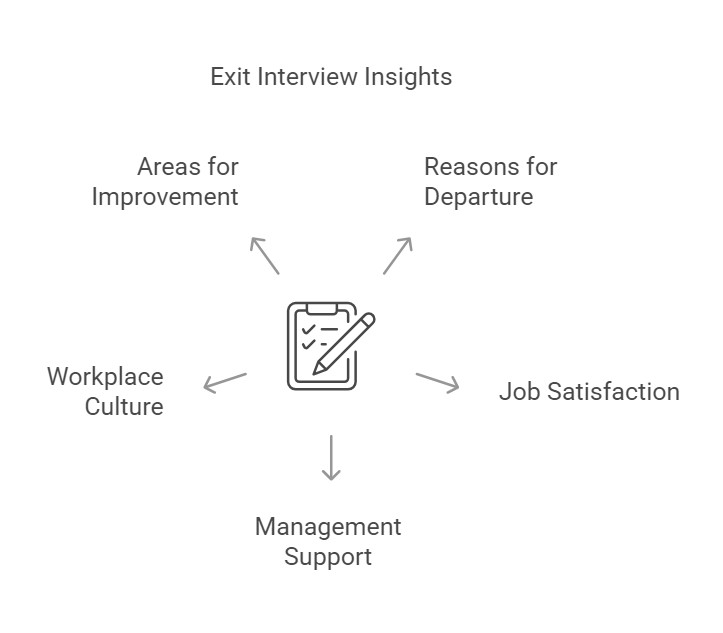- Research platform
Sources of information
Data analysis
Actions
- Solutions
For whom
Problems / Issues
- Materials
Materials
- About us
About us

Exit interview questionnaires collect crucial insights about exit interviews and their role in organizations. What is an exit interview? These conversations take place when an employee leaves a company, revealing trends and reasons behind employee turnover. Constructive feedback gathered during these interviews can enhance organizational growth and employee satisfaction. This guide shows exit interview best practices.
It emphasizes the importance of exit interview questionnaires. You’ll learn how to create effective questions for actionable feedback. Avoiding common mistakes is needed too. Analyzing the data from exit interviews gives insights into workplace culture.
Implementing feedback can improve retention. Therefore, both managers and HR professionals can benefit from this information. Enhance your exit processes by using the tips shared in this guide. We discuss how to conduct an exit interview which informs and improves your business as a whole. Dive into the details with it and discover how effective these interviews can be.

Exit interviews are important conversations that happen when employees leave. These discussions help companies to learn why people are departing. They usually occur during the offboarding process. Exit interviews aim to gather insights from employees about their time at the company. They also give businesses feedback that can help improve overall satisfaction.
Exit interviews are very useful. A good exit interview can show patterns in why people leave jobs. Research shows that many workers, over 50%, leave due to limited career growth. When companies listen to employee feedback from exit interviews, they can address these issues and improve workplace culture.
Additionally, exit interviews help organizations review their management and communication. This feedback is key to spotting problems that often go unnoticed in routine feedback. For example, nearly 66% of employees disengaged feel communication lacks. The exit interview process therefore helps find communication gaps, promoting a better work environment.
In conclusion, conducting exit interviews is essential for any organization focused on improving its atmosphere and keeping talent. The information collected from these meetings can lead to meaningful organizational changes. Thus, they become a vital part of managing employees over their lifecycle.
Next, we will look into exit interview questionnaires and the benefits they provide for gathering this crucial feedback.
An exit interview is a structured conversation between a departing employee and a representative from the organization, typically someone from the HR department. The primary goal of an exit interview is to gather honest feedback from the departing employee about their overall experience with the company, focusing on the employee's experience. This includes understanding their reasons for leaving, what they liked and disliked about their role, and any suggestions they might have for improvement. By conducting an exit interview, organizations can gather honest feedback that provides valuable insights into areas that may need attention, helping to enhance workplace culture and increase employee retention.
Conducting exit interviews is crucial for organizations aiming to understand the underlying reasons behind employee turnover and to identify opportunities for growth and improvement. By gathering feedback from departing employees, companies can gain a deeper understanding of their strengths and weaknesses. This information is invaluable for informing strategies to improve employee engagement, retention, and overall job satisfaction. Additionally, exit interviews offer a chance to maintain a positive relationship with departing employees, which can be beneficial for future references and potential boomerang hiring. By conducting exit interviews on a positive note, organizations can create a more engaging and satisfying work environment for both current and future employees.
Preparing for an exit interview is essential to ensure that the conversation is both productive and informative. Here are some steps to help you prepare effectively:
It’s important to schedule the exit interview well in advance, ideally during the departing employee’s last week or on their last day. This timing allows the employee to reflect on their experience and provides a sense of closure. Make sure to choose a time and date that works for both the employee and the interviewer, ensuring that the conversation can take place without interruptions.
Having a list of open-ended questions prepared in advance can help guide the conversation and ensure that you cover all relevant aspects of the employee’s experience. These questions should touch on various areas, such as reasons for leaving, job satisfaction, communication with management, and opportunities for training and development. Some examples of effective exit interview questions include:
By preparing your questions in advance, you can ensure that the conversation remains focused and productive, allowing you to gather valuable insights from the departing employee.
Conducting an exit interview requires a structured approach to ensure that you gather valuable and actionable feedback from the departing employee. Here are some tips to help you conduct a successful exit interview:
Some examples of open-ended questions to ask during an exit interview include:
By conducting a structured and empathetic exit interview, you can gather valuable feedback and insights from departing employees, and use this information to improve your company culture and employee experience.
Exit interview questionnaires play key roles in improving workplace environments. They help gather honest feedback about the employee's experience and reasons for leaving. This discussion can provide insights on satisfaction, workplace culture, management practices, and others.
A further benefit of these exit interview questionnaires is determining trends in employee turnover. Employers can analyze the responses to find recurring problems and critical areas for action. For example, if many departing employees mention a lack of career growth, this indicates a need for leadership to tackle retention issues.
Additionally, feedback from these questionnaires can refine onboarding for future hires. Learning why employees leave can strengthen onboarding efforts to reduce similar exits later. Adapting these procedures supports employee connection and contributes to having a stable workforce.
Studies show organizations that properly use exit interview feedback experience greater employee satisfaction. This is evident from the 87% of employers who view exit interviews as vital for retention strategies. Such an approach helps a company learns from past experiences, listening to reasons from departing staff and creating an engaging workplace.
In the next part about good ways to conduct exit interviews, it’s important to keep in mind that well-structured questionnaires significantly boost the value of insights. They guide companies in ongoing development efforts.
Exit interview questionnaires allow organizations to gain insights from departing employees. It’s important to follow best practices for these interviews to be effective. Start scheduling exit interviews for the employee’s last day. This timing keeps the details fresh in their minds and allows war for honest talks since they feel free from workplace ties.
Also, involve a neutral party during the interviews. Using a human resources consultant or impartial internal employee makes it easier for honest feedback. Employees may feel safer sharing their feelings about the organization and its culture when they know their concerns will be treated confidentially.
Promoting confidentiality is central to getting candid responses. Employees are more likely to express true feelings when they believe their comments won’t be traced back to them or used against them. This trust can produce critical insights that might otherwise stay hidden.
Moreover, focus on specific areas when conducting exit interviews. Areas like job satisfaction, workplace culture, and reasons for leaving can show actionable insights. Research reveals organizations using feedback from exit interviews can lower turnover rates by 14%.
Lastly, always follow up on feedback received, including negative feedback. It’s key to show that current and future employees’ input matters and that it can invoke changes in the organization. Executing steps based on exit interview insights fosters a culture of improvement, proving to employees their voices matter.
After applying these practices, the next step is to analyze the responses gathered from exit interviews. In the upcoming section, we’ll review frequent exit interview questions to help guide conversations and reveal valuable information.

A successful exit interview serves as an important method for companies who want to grasp why employees leave, and they help identify where improvements are necessary. Crafting a solid exit interview questionnaire is vital to guide fruitful conversations during interviews. Here are typical questions to steer these talks.
Firstly, ask about the reasons for their departure. This inquiry clarifies the motivations of the employee and gives important insights into possible issues within the organization. A question like, “What led you to look for new job opportunities?” can show if the exit was due to outside options, workplace problems, or personal reasons.
Overall job satisfaction is another key point to explore. Queries such as, “How satisfied were you with your job and what you did?” or “Do you think your input was appreciated?” expose strengths and weaknesses in management styles as well as the office culture.
Including questions about management support remains important. For instance, questions such as, “Did you feel your supervisor was supportive?” or “What could management done better to support you?” provide needed feedback on the effectiveness of leaders and their approach within teams.
Additionally, feedback on workplace culture is quite useful. Questions like, “How would you explain the company culture?” and “What parts of the culture did you find hardest?” helps organizations learn how their culture impacts employee retention.
Moreover, pin-pointing areas for improvement remains vital. Questions like, “What ideas could you suggest for enhancing the work setting?” or “Were there any tools you needed that were not given?” invites departing employees to express their views on ways to boost effectiveness and employee satisfaction.
By organizing exit interview questionnaires around these standard questions, companies can gather useful data which not only brings to light current issues but also indicates paths for future growth. Thus, employing best methods for conducting exit interviews fosters a better employee experience overall.
Once data is collected from exit interviews, the next necessary step involves reviewing this information to find patterns and usable insights. This review plays a key role in forming company policies and improving the workplace for both current and future employees.
Exit interview questionnaires help understanding why employees leave a company. This analysis is crucial. It reveals trends and common issues that can improve the organization. Exit interviews show that 55% of employees mentioned lack of career growth as a reason for leaving. This shows growth opportunities matter in work life.
By focusing on exit interview data, companies can find insights that promote positive changes. A recurring problem in workplace culture could lead firms to start diversity training or initiatives that enhance teamwork. A notable company listened to exit interviews and changed their performance review system. It became clearer and cut turnover by 10% year after year.
Additionally, data from exit interviews can change management styles. If many employees mention problems with their supervisors, it may trigger management to consider leadership training. Adapting how managers work with teams can meet worker needs better. Research indicates that enhancing management communication lowers turnover rates by 14%.
Using findings from exit interviews in planning can help keep staff and boost satisfaction levels. Companies should gather and examine exit interview questionnaires for better future practices aimed at retaining employees.
After collecting and analyzing data, organizations must act on feedback from exit interviews. This step is vital for turning insights into strategies that enhance employee retention and boost workplace satisfaction.
Once you analyze exit interview questionnaires, the next key step is to implement feedback. This process include compiling findings and sharing across the organization to drive improvement. Start by categorizing feedback into key areas like workplace culture or management practices. It helps to find patterns and prioritize issues needing immediate attention.
Making follow-up actions based on feedback from exit interviews is essential. If several employees mention lack of career development, HR should work on structured career path program. Studies show organizations that act on feedback from exit interviews reduce turnover by as much as 30%. This fact shows the impact of using exit interview info to boost retention.
Also, it's vital to communicate changes made from exit interviews to current employees. This maintains trust and transparency in the organization. Regular updates about improvements or new initiatives from exit interviews insights show employees their voices matter. This communication helps to foster company culture which can lead to better engagement and morale. It further reduces resignation rates.
In summary, using feedback from exit interviews needs systematic approach in compiling data, taking actions based on gathered insights, and keeping open communication with current employees about changes. By focusing on these elements, organizations can improve their exit interview process. It creates positive workplace environment and enhance retention rates.
Exit interviews offer a range of benefits for companies, including:
By conducting exit interviews, companies can gain a deeper understanding of their employees’ experiences and perspectives, and use this information to make positive changes to their company culture and employee experience.
When conducting exit interviews, there are several common mistakes to avoid, including:
By avoiding these common mistakes, companies can ensure that their exit interviews are successful and provide valuable feedback and insights from departing employees.
In conclusion, understanding exit interview questionnaires is key for every organization serious about talent retention. This guide explained what is an exit interview, its main purposes, and the benefits of effective exit interview questionnaires. When using best practices, organizations can gain insights.
You now know how to conduct exit interviews well. It's time to use this knowledge. Begin using effective exit interview questionnaires in your offboarding process. Pay attention to feedback and be sure to take actions based on what you learn. Exit interviews should drive growth.
As you move forward, value the insights from exit interviews. These insights can enhance workplace culture and retain valuable employees. So, refine your exit interview process for a better future. Make these interviews count, because they are powerful tools for improvement.
Copyright © 2023. YourCX. All rights reserved — Design by Proformat